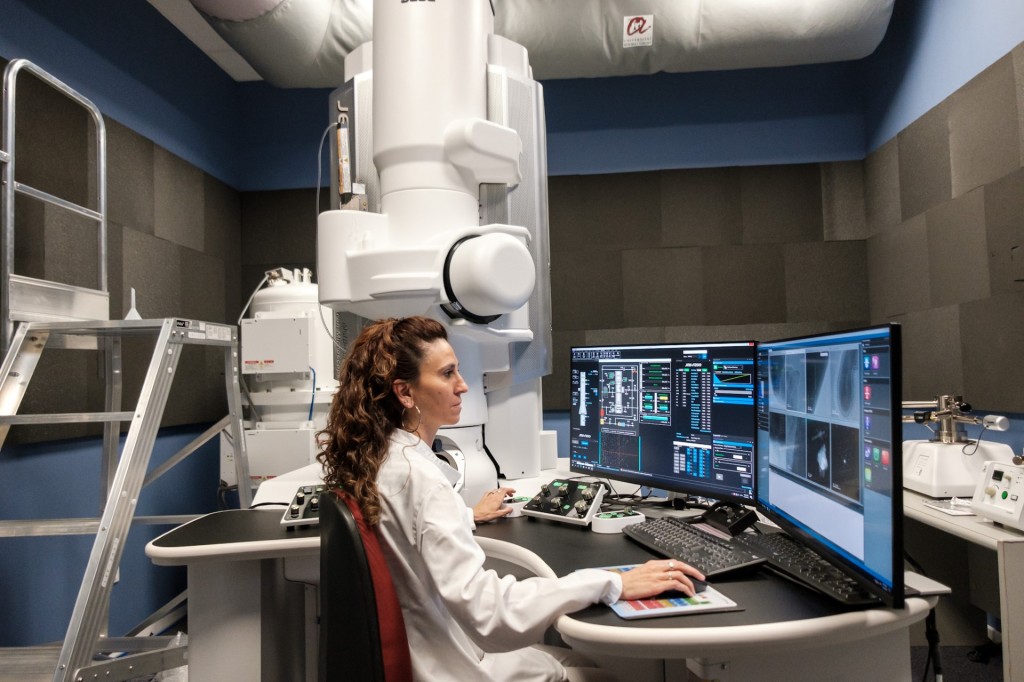17/07/2023
A high-resolution transmission electron microscope completes the CatSud Nanotechnology Platform
The Universitat Rovira i Virgili now has a leading infrastructure of great usefulness in the fields of nanoscience and nanotechnology.

The Universitat Rovira i Virgili now has a leading infrastructure of great usefulness in the fields of nanoscience and nanotechnology.
The CatSud Nanotechnology Platform at the Universitat Rovira i Virgili has recently been completed with the installation of an atomic resolution transmission electron microscope. This equipment, known by the acronym HRTEM, complements the already operational high-resolution scanning electron microscope. The URV is thus equipped with a leading scientific-technical infrastructure to respond to the growing need for characterization – the study and measurement of the structure and properties of materials – in the fields of nanoscience and nanotechnology. The URV is now one of the first places in Catalonia where both instruments can be used together to make three-dimensional characterizations of all types of material.
The high-resolution transmission electron microscope cost 1.3 million euros, 50% of which was co-financed by the European Regional Development Fund of the European Union under the ERDF operational programme for Catalonia 2014-2020 and with the support of the Department of Research and Universities.
Mercè Moncusí and Martí Yebras, from the URV’s Scientific and Technical Resources Service (SRCiT), claim that the new microscope is a key tool for the analysis of materials at the atomic level: “Its versatility makes it possible to study matter using microscopy, crystallography and spectroscopy, the three indispensable fields for understanding the structure of materials in detail. In addition, its cutting-edge technology provides researchers with the ideal microscope for studying the structure and properties of both materials and organisms.”
Sergi Plana, the person responsible for the HRTEM, explains that “the new microscope generates the electron beam through a cold field emission gun that provides very little energy dispersion. Thanks to this technology and the acceleration of the electrons through a voltage of 200 kV (about a thousand times the voltage supplied by household sockets), images of matter at the atomic level can be obtained with resolutions of up to 1.4 angstroms.” It should be noted that one angstrom is equivalent to one ten-billionth of a meter. The flexibility of the HRTEM’s optical system also makes it possible to work at 80 kV, which is very important for effectively characterizing two-dimensional materials such as graphene or tungsten disulphide, and biological samples.
Projects using the CatSud Nanotechnology Platform
The CatSud Nanotechnology Platform is already providing services to researchers from the University’s scientific community, the ICIQ and the Eurecat technology centre, as well as to companies in the region. Some of the applications in which the platform is already involved include the characterization of catalysts used to generate hydrogen from the decomposition of water, the evaluation of ferroelectric materials used in light sensors, the study of multilayer systems used in solar cells and the observation of possible new cathodes for electric batteries. The high versatility of HRTEM is also beneficial to both the chemical and pharmaceutical industries, since it can be used to make more precise studies of elemental distributions in various chemical compounds, see the crystallization of pharmaceutical compounds in real time, investigate cocrystals and even characterize amorphous solid dispersions.
The mission of the CatSud Nanotechnology Platform is to make the most advanced infrastructures for characterizing all sorts of nanoscale material available to the scientific community and professionals in the sector. The fact that it is now available consolidates existing research lines, opens up emerging lines and increases internationalization and specialization. Thus, it reinforces the collaboration between the main organizations responsible for research and transfer in the region, and improves synergies for developing and innovating with industry.
